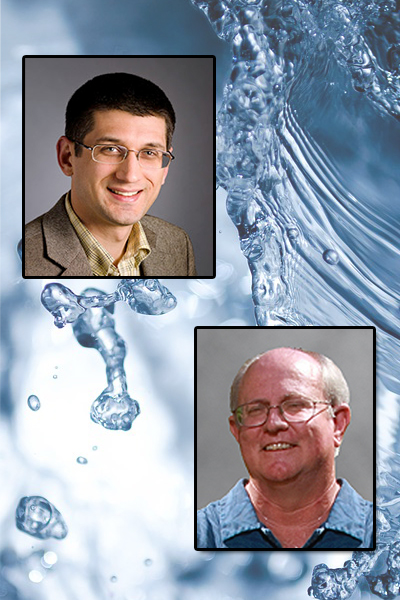Making a Splash: Wiedner and Linehan Review How Liquids Alter Reactions That Store Energy
Often ignored, solvents are major players
(July 2018)

Eric Wiedner (left) and John Linehan wrote an invited mini-review on solvents and the hydrogenation of carbon dioxide.
Would you buy a computer that only worked on breezy days? A stove that only heated when it was sunny? Wind and solar energy must be used immediately or lost. But what if the energy was stored as fuel? One way to create such fuel is to use renewable energy to turn water into oxygen and hydrogen gas. That's relatively easy. Take the hydrogen and react it with carbon dioxide to create a fuel. That's not so easy.
While the hydrogen, carbon dioxide, and catalysts are being studied intently, the reaction's liquid "home" (solvent) is often overlooked. Dr. Eric Wiedner and Dr. John Linehan at Pacific Northwest National Laboratory (PNNL) are correcting that oversight. They've reviewed the state of solvent research and offer their insights in an invited article in Chemistry-A European Journal. "It was satisfying to help define future research directions for the field and to encourage others to think about how the solvent can be used," said Wiedner.
In the article, Wiedner and Linehan discuss how solvents influence hydrogen chemistry, specifically hydride transfer. They review research into how water speeds hydride transfer in certain cases. For example, water turns an acceptable cobalt catalyst into a top performer.
They also look at how the solvent affects the carbon dioxide. For example, they took on a longstanding question about carbon dioxide's conversion. What was the catalyst actually converting? Is it the carbon dioxide or carbonates, compounds formed by carbon dioxide in water? Wiedner and Linehan analyzed thermodynamic data to show that carbon dioxide is more likely to be acted upon.
Finally, Wiedner and Linehan looked at how the solvent affects the final products. Hydrogen and carbon dioxide can produce a range of fuels and chemicals, including formic acid, formate, and methanol. For example, European and Japanese studies show a certain solvent can lead to methanol fuel under mild conditions. However, the mechanism involved wasn't described in detail. Wiedner and Linehan determined how it worked by assembling thermodynamic data from the literature.
By considering the influence of solvents, researchers can design faster, more efficient ways to store renewable energy. "We show how you can control the reaction without making fancier, more expensive catalysts," said Wiedner.
Eric Wiedner: His research focuses on the rational design of catalysts to convert carbon dioxide into valuable chemicals. He joined PNNL in 2009 and is a co-principal investigator on two catalysis efforts funded by the Department of Energy's Office of Science.
John Linehan: With more than 30 years in field, he's known for his experimental research into the inner workings of catalysts and their environments using techniques, including high-pressure and operando spectroscopy. He has published extensively and worked on numerous projects funded by the Department of Energy's Office of Science.
Acknowledgments
Sponsor: Department of Energy, Office of Science, Basic Energy Sciences, Chemical Sciences, Geosciences, and Biosciences Division
Research Team: Eric Wiedner and John Linehan
Reference: E.S. Wiedner and J.C. Linehan, "Making a splash in homogeneous CO2 hydrogenation: Elucidating the impact of solvent on catalytic mechanisms." Chemistry - A European Journal. [DOI: 10.1002/chem.201801759]
